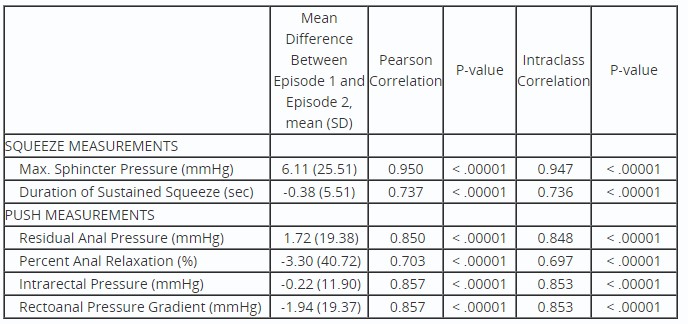Oral Paper Presentation
Annual Scientific Meeting
Session: Plenary Session 2A - Functional / Esophagus
22 - Intra-Subject Reproducibility of Squeeze and Push Metrics in High-Resolution Anorectal Manometry: Assessing the Need for Multiple Attempts
Tuesday, October 24, 2023
9:00 AM - 9:10 AM PT
Location: Ballroom A

Ofer Fass, MD
Stanford University
Mountain View, CA
Presenting Author(s)
Ofer Fass, MD1, Leila Neshatian, MD, MSc2
1Stanford University, Mountain View, CA; 2Stanford, Redwood City, CA
Introduction: High-resolution anorectal manometry (HR-ARM) is the most widely used test for evaluating rectal and anal sphincter pressures and function. The standardized testing protocol recommended by the international anorectal physiology working group (IAPWG) involves three 5-second squeezes and three 15-second pushes. Although multiple attempts are thought to improve test accuracy, they also lengthen the procedure potentially burdening patients. We aimed to assess the intra-subject reproducibility of squeeze and push metrics during HR-ARM to determine the necessity of multiple maneuvers.
Methods: This retrospective study included patients who underwent HR-ARM at a single academic center from January 2018 to February 2023. Patients with at least two repeated squeeze and push measurements were included. Squeeze metrics (maximum sphincter pressure and sustained duration) and push metrics (residual anal pressure, percent anal relaxation, intrarectal pressure, and rectoanal pressure gradient) were measured. Intra-subject reproducibility between the first (episode 1) and second (episode 2) measurements was assessed using Pearson correlation and intraclass correlation (ICC) with two-way random effects, estimating absolute agreement.
Results: A total of 1,085 patients (27% men), with a mean age of 53 years, and mean BMI 26 kg/m2 were included. The racial distribution included 59% White, 15% Asian, 2% Black, and 15% Hispanic individuals. Maximum sphincter pressure demonstrated excellent reproducibility (r = 0.95, ICC = 0.95; P < 0.001), while the duration of sustained squeeze showed good, albeit lower, reproducibility (r = 0.74, ICC = 0.74; P < 0.001). Among the push parameters, residual anal pressure, intrarectal pressure, and rectoanal pressure exhibited similar levels of reproducibility (r = 0.85-0.86, ICC = 0.85; P < 0.001). Percent anal relaxation demonstrated good reproducibility, albeit lower than other push metrics (r = 0.70, ICC = 0.70; P < 0.001).
Discussion: In this large cohort of patients with a wide range of anorectal complaints and pathologies, both push and squeeze measurements showed a high degree of reproducibility in HR-ARM. Whether changes in the absolute values in repeated maneuvers may alter the diagnosis needs to be further investigated. Our study suggests a need for reappraisal of the IAPWG protocol


Disclosures:
Ofer Fass, MD1, Leila Neshatian, MD, MSc2, 22, Intra-Subject Reproducibility of Squeeze and Push Metrics in High-Resolution Anorectal Manometry: Assessing the Need for Multiple Attempts, ACG 2023 Annual Scientific Meeting Abstracts. Vancouver, BC, Canada: American College of Gastroenterology.
1Stanford University, Mountain View, CA; 2Stanford, Redwood City, CA
Introduction: High-resolution anorectal manometry (HR-ARM) is the most widely used test for evaluating rectal and anal sphincter pressures and function. The standardized testing protocol recommended by the international anorectal physiology working group (IAPWG) involves three 5-second squeezes and three 15-second pushes. Although multiple attempts are thought to improve test accuracy, they also lengthen the procedure potentially burdening patients. We aimed to assess the intra-subject reproducibility of squeeze and push metrics during HR-ARM to determine the necessity of multiple maneuvers.
Methods: This retrospective study included patients who underwent HR-ARM at a single academic center from January 2018 to February 2023. Patients with at least two repeated squeeze and push measurements were included. Squeeze metrics (maximum sphincter pressure and sustained duration) and push metrics (residual anal pressure, percent anal relaxation, intrarectal pressure, and rectoanal pressure gradient) were measured. Intra-subject reproducibility between the first (episode 1) and second (episode 2) measurements was assessed using Pearson correlation and intraclass correlation (ICC) with two-way random effects, estimating absolute agreement.
Results: A total of 1,085 patients (27% men), with a mean age of 53 years, and mean BMI 26 kg/m2 were included. The racial distribution included 59% White, 15% Asian, 2% Black, and 15% Hispanic individuals. Maximum sphincter pressure demonstrated excellent reproducibility (r = 0.95, ICC = 0.95; P < 0.001), while the duration of sustained squeeze showed good, albeit lower, reproducibility (r = 0.74, ICC = 0.74; P < 0.001). Among the push parameters, residual anal pressure, intrarectal pressure, and rectoanal pressure exhibited similar levels of reproducibility (r = 0.85-0.86, ICC = 0.85; P < 0.001). Percent anal relaxation demonstrated good reproducibility, albeit lower than other push metrics (r = 0.70, ICC = 0.70; P < 0.001).
Discussion: In this large cohort of patients with a wide range of anorectal complaints and pathologies, both push and squeeze measurements showed a high degree of reproducibility in HR-ARM. Whether changes in the absolute values in repeated maneuvers may alter the diagnosis needs to be further investigated. Our study suggests a need for reappraisal of the IAPWG protocol

Figure: Bland-Altman plot demonstrating reproducibility of percent anal relaxation. Differences between measurements are plotted against the average of the two measurements. The horizontal black line at -3.3% represents the mean difference. The dashed red lines at 76.5% and -83.1% represent limits of agreement within 2 standard deviations.

Table: Comparison of mean differences, correlations, and intraclass correlations between episode 1 and episode 2 for squeeze and push measurements during high-resolution anorectal manometry (HR-ARM) testing.
Disclosures:
Ofer Fass indicated no relevant financial relationships.
Leila Neshatian: salix, Ardelyx, GI supply, Vibrant – Advisory Committee/Board Member, Consultant.
Ofer Fass, MD1, Leila Neshatian, MD, MSc2, 22, Intra-Subject Reproducibility of Squeeze and Push Metrics in High-Resolution Anorectal Manometry: Assessing the Need for Multiple Attempts, ACG 2023 Annual Scientific Meeting Abstracts. Vancouver, BC, Canada: American College of Gastroenterology.
